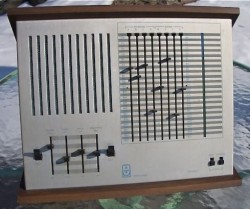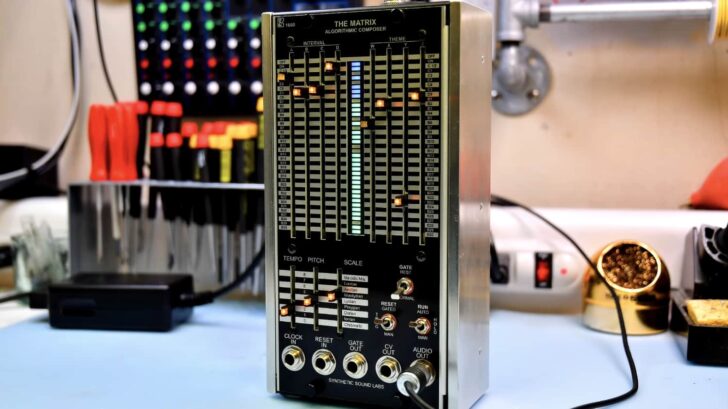Synthetic Sound Labs has introduced The Matrix, a deterministic algorithmic sequencer, inspired by the rare Triadex Muse.

The Triadex Muse, developed by Edward Fredkin and Marvin Minsky around 1969, was described in its patent as a note generator, controlled by a long term, quasi-periodic function, which is in turn generated by applying digital feedback in preselected combinations around a digital register.
Or as the inventors said at the time, “The apparatus thus, in effect, composes music as distinguished from merely synthesizing sound.”
The Matrix can play up to 16 notes, in 9 different user-selected scales. Notes and sequences are programmed by use of 8 sliders. Each slider has 38 active positions, each of which is associated with an LED.
Four sliders on the left control the sequencer’s pitch, and the four sliders on the right assign binary feedback into the sequence, creating musical permutations that make The Matrix so unique.
The TEMPO slider controls the speed of the sequence, and this internal clock signal is also brought out to the GATE OUT jack. An external clock (CLOCK IN) can override the internal clock, providing more flexibility, with a range up to about 2KHz.
Expanding upon the original Muse, The Matrix has a 9-position user selectable SCALE slider, which affects both an internal square-wave tone generator and the CV OUT jack. The internal tone is available at the AUDIO OUT jack, and the CV OUT jack is approximately 1V/OCT.
The PITCH slider controls the pitch range of the internal generator over about 5 octaves and does not affect the CV OUT. A RESET IN jack restarts the sequence from the beginning and is affected by two positions of the RESET switch.
SSL 1660 In-depth Demo:
Pricing and Availability
The Matrix is available now for $425 USD.


Cool, the interface reminds me of the Vermona MeloDICER. Shame, that neither has MIDI.
Just in case you didn’t notice yet, Vermona came out with a MIDI I/O expansion module for the meloDICER recently.
still silly.